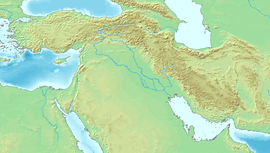
Back قصر عقيل Arabic قصر عقيل ARZ Ksar Akil German Ksar Akil Spanish Ksar Akil French Ksar Akil Italian Ksar Akil Dutch Кзар-Акил Russian
 | |
| Alternative name | Ksar 'Aqil |
|---|---|
| Location | 10 km (6.2 mi) northeast of Beirut |
| Coordinates | 33°54′43″N 35°36′12″E / 33.91185°N 35.60325°E |
| Type | Rock shelter |
| History | |
| Periods | Middle Palaeolithic, Upper Palaeolithic, Epipaleolithic (Levant) |
| Cultures | Transitional/Initial Upper Palaeolithic, Ahmarian Northern Facies, Levantine Aurignacian |
| Site notes | |
| Excavation dates | 1937-1938, 1947-1948, 1969-1975 |
| Archaeologists | J.G. Doherty: Boston College, J.F. Ewing: Fordham University, Jacques Tixier: CNRS |
| Public access | Yes |




Ksar Akil (also Ksar 'Akil or Ksar Aqil[3]) is an archeological site 10 km (6.2 mi) northeast of Beirut in Lebanon. It is located about 800 m (2,600 ft) west of Antelias spring on the north bank of the northern tributary of the Wadi Antelias. It is a large rock shelter below a steep limestone cliff.[4]
It was first noticed by Godefroy Zumoffen in 1900[5] and first studied by A. E. Day in 1926[6] then first systematically excavated by J.G. Doherty, S.J., and J.F. Ewing, S.J., in 1937-1938 and again in 1947-1948, then later by Jacques Tixier in 1969-1975 before research was interrupted by the Lebanese Civil War.
Excavations showed occupational deposits reaching down to a depth of 23.6 m (77 ft) with one of the longest sequences of Paleolithic flint industries ever found in the Middle East. The first level of 8 m (26 ft) contained Upper Levallois-Mousterian remains with long and triangular Lithic flakes. The level above this showed industries accounting for all six stages of the Upper Paleolithic. An Emireh point was found at the first stage of this level (XXIV), at around 15.2 m (50 ft) below datum, in association with the hominin mandible Ksar Akil 2. Studies by Hooijer showed Capra and Dama were dominant in the fauna along with Stephanorhinus in later Levalloiso-Mousterian levels.[4]
It is assumed to be one of the earliest known sites containing Upper Paleolithic technologies including Ahmarian cultural objects. Artifacts recovered from the site include Ksar Akil flakes, the main type of tool found at the site, along with pierced shells and chipped edge modifications that suggest these have been used as pendants or beads. This indicates that the inhabitants were among the first in Western Eurasia to use personal ornaments. Results from radiocarbon dating indicate that the early humans may have lived at the site approximately 45,000 years ago or earlier. The presence of personal ornaments at Ksar Akil is suggestive of modern human behavior. The findings of ornaments at the site are contemporaneous with ornaments found at Late Stone Age sites such as Enkapune Ya Muto.[7][8][9]
The site was rescued from burial under the sludge of gravel-making machines in 1964 by the Department of Antiquities, although is mostly unrecognizable due to quarrying operations with its talus buried under tons of soil.[4]
Aside from 10 teeth from Üçağızlı Cave in southern Turkey, Ksar Akil is the only site with hominin remains from the Early Upper Paleolithic and Initial Upper Paleolithic in the Levant discovered so far.[10][1]
- ^ a b c Higham, Thomas F. G.; Wesselingh, Frank P.; Hedges, Robert E. M.; Bergman, Christopher A.; Douka, Katerina (2013-09-11). "Chronology of Ksar Akil (Lebanon) and Implications for the Colonization of Europe by Anatomically Modern Humans". PLOS ONE. 8 (9): e72931. Bibcode:2013PLoSO...872931D. doi:10.1371/journal.pone.0072931. ISSN 1932-6203. PMC 3770606. PMID 24039825.
- ^ Higham, Thomas F. G.; Wesselingh, Frank P.; Hedges, Robert E. M.; Bergman, Christopher A.; Douka, Katerina (2013-09-11). "Chronology of Ksar Akil (Lebanon) and Implications for the Colonization of Europe by Anatomically Modern Humans". PLOS ONE. 8 (9): e72931. Bibcode:2013PLoSO...872931D. doi:10.1371/journal.pone.0072931. ISSN 1932-6203. PMC 3770606. PMID 24039825.
- ^ Wiley-Blackwell encyclopedia of human evolution. Wood, Bernard A., Wiley InterScience (Online service). Chichester, West Sussex: Wiley-Blackwell. 2011. ISBN 9781444342499. OCLC 739118512.
{{cite book}}: CS1 maint: others (link) - ^ a b c Lorraine Copeland; P. Wescombe (1965). Inventory of Stone-Age sites in Lebanon, p. 100-101. Imprimerie Catholique. OCLC 917417205.
- ^ Zumoffen, G., La Phénicie avant les Phéniciens, Imprimerie Catholique, Beirut, 1900.
- ^ Day, A.E., The Rock Shelter of Ksar Akil near the Cave of Antilias, Quarterly Statement of the Palestine Exploration Fund, 1926
- ^ Kuhn, Steven; Stiner, MC; Reese, DS; Güleç, E (2001). "Ornaments of the earliest Upper Paleolithic: New insights from the Levant". Proceedings of the National Academy of Sciences. 98 (13): 7641–6. Bibcode:2001PNAS...98.7641K. doi:10.1073/pnas.121590798. PMC 34721. PMID 11390976.
- ^ Douka, K. 2011. An Upper Palaeolithic shell scraper from Ksar Akil (Lebanon). Journal of Archaeological Science 38 (2):429-437
- ^ "Kuhn, Steven L., Stiner, Mary C., Reese, David S., Güleç, Erksin., Ornaments of the earliest Upper Paleolithic: New insights from the Levant, Edited by Henry C. Harpending, PNAS, June 5th 2001". Archived from the original on 2019-10-15. Retrieved 2011-03-27.
- ^ Cite error: The named reference
:0was invoked but never defined (see the help page).
© MMXXIII Rich X Search. We shall prevail. All rights reserved. Rich X Search

